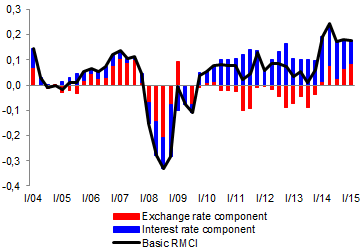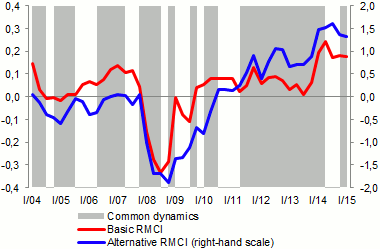The monetary conditions index for the Czech Republic
This box describes the monetary conditions in the Czech Republic using the real monetary conditions index (RMCI). The basic version of the RMCI is calculated as the weighted average of the deviations of domestic ex ante real interest rates and the real exchange rate from their equilibrium levels (see Chart 1). The components of the RMCI are weighted 3:1 in favour of interest rates.1 In this sense, the RMCI describes the aggregate monetary policy stance. The interest rate component of the RMCI consist of the 3M PRIBOR market rate adjusted for financial market inflation expectations one year ahead. The exchange rate component is expressed as the deviation of the effective real exchange rate from the midpoint of the range of estimates of its equilibrium levels.
Chart 1 (BOX) Basic version of RMCI
The monetary conditions have been very accommodative since the end of 2013, albeit rather less so recently as a result of a fall in inflation expectations
(positive values refer to easy monetary conditions and negative values to tight monetary conditions; source: CNB, CNB calculation)

A key question is how the monetary conditions effect the demand side of the economy. An alternative monetary conditions index has been constructed for this purpose. This describes the broader monetary conditions and was inspired by the literature on the construction of financial conditions indices using FAVAR models. In this case, the monetary conditions are seen not merely as a combination of settings of monetary policy instruments, as their effect on each sector of the real economy is also taken into account. The alternative index thus reflects the monetary conditions in terms of their affect on the end of the transition mechanism, i.e. via the interest rates relevant to each sector in the economy and via the real exchange rate of the koruna. The disadvantage of this index is that the source of its movements cannot be identified. This stems from the fact that the index is not a mere linear combination of input series, as in the basic version, because the weights change in every time period.
Both indices (see Chart 2) indicate an easing of the monetary conditions in 2005–2007 and a subsequent tightening due to a sharp appreciation of the koruna and an increase in interest rates in response to an overheating economy and rising inflation. This was followed by a rapid easing of the monetary conditions (according to the basic version of the index mainly in the interest rate component and temporarily also in the exchange rate component) in reaction to the global financial and economic crisis. A further easing of the monetary conditions is apparent in late 2013 and early 2014 both through the direct effect of the weakening of the koruna on the real exchange rate (the adoption of the exchange rate commitment by the CNB) and due to an increase in inflation expectations. Since then, the domestic real monetary conditions have been very accommodative, albeit rather less so recently as a result of a fall in financial market analysts’ inflation expectations one year ahead.
Chart 2 (BOX) Comparison of basic and alternativ versions of RMCI
The two indices offer a very similar picture of the real monetary conditions in recent years
(for the basic RMCI positive values refer to easy monetary conditions and for the alternative RMCI a rise in value refers to an easing of the monetary conditions; source: CNB, CNB calculation)

1 The index weights correspond to the accumulated strength of the impulse responses of the output gap to an interest rate shock (the weight for the interest rate component) and an exchange rate shock (the weight for the exchange rate component). A horizon of 1–8 quarters was chosen for robustness. This encompasses the standard monetary policy horizon. In addition, according to impulse responses, the strongest effect of interest rate and exchange rate shocks on the output gap and inflation rates fades away within this time scale.